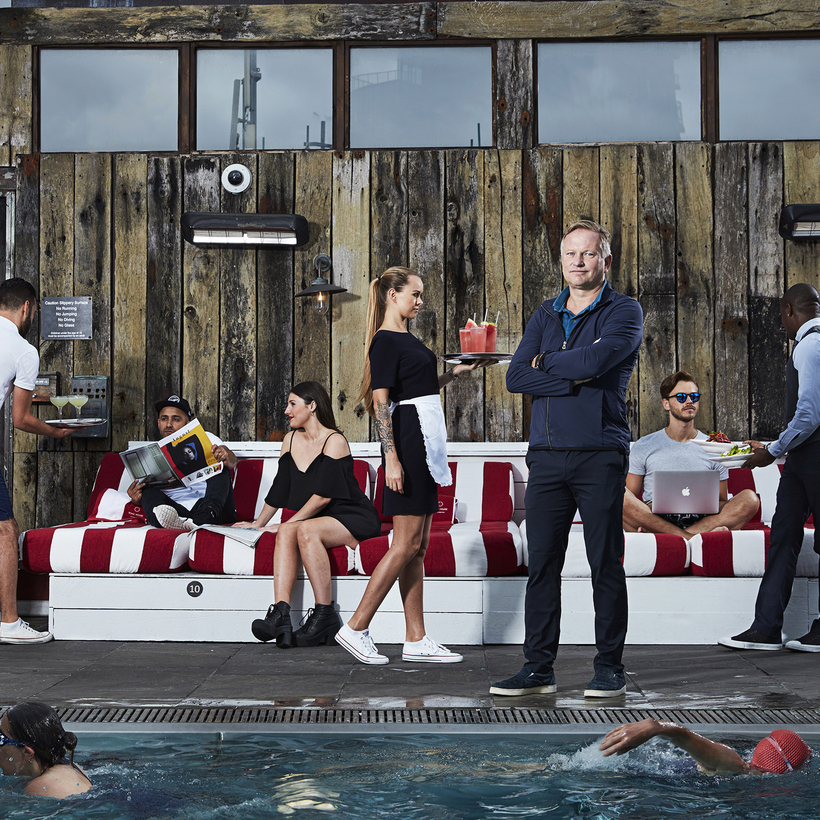Soho House is preparing to go public in the same way it operates its clubs: subtly, but not that subtly. In the beginning of April, the London-based private-club company, which bills itself as an oasis of exclusivity and swank, submitted a confidential filing for an I.P.O. in New York that will value the company at more than $3 billion. That same week, Sky News broke the story.
Soho House hired J. P. Morgan and Morgan Stanley to help plan for an I.P.O. following a first, pulled attempt in 2018. It’s bullish on its timing this go-round—travel-and-leisure stocks are expected to boom post-pandemic—and big names are buying in, such as Goldman Sachs, who just loaned Soho House $770 million ahead of the I.P.O.
In November, Nick Jones, the company’s founder, told The Telegraph that the clubs have a combined waiting list of about 50,000 people. The next few months will see the opening of four new locations, in Tel Aviv, Rome, Paris, and Austin. It’s all sounding pretty good.
The problem? There’s absolutely no more cool factor left.
Creative Solutions
Jones opened the first Soho House space, in London’s West End, in 1995. The idea, he said, was to create a “home for creative people to come together,” and it marketed itself as highly selective and catering to an artsy crowd. For a while, it worked: you had to know someone to get in, it was hard to get in, and finance bros weren’t allowed in.
Since then the club has expanded to 110,000 members across 27 locations in 10 countries (pre-pandemic). The trouble is that there just aren’t that many “creative people” in the world—or at least enough of them willing to pay good money to join a club such as Soho House.

In 2012, Ronald Burkle, the American billionaire investor and co-owner of the Pittsburgh Penguins hockey team, bought a 60 percent stake in Soho House, in a deal that then valued the company at an estimated $350 million. Richard Caring, who owns Annabel’s nightclub and a string of high-end restaurants in London, is now Soho House’s second-biggest investor.
As Nick Jones’s profile got bigger—Harry and Meghan had their first date at Dean Street Townhouse, a Soho House club—he no doubt realized what any sane person could have told him all along: you can’t grow like crazy and maintain exclusivity. So the bankers, inevitably, started rolling in.
With an I.P.O. in the works, Soho House is about to get even more unexclusive. It shouldn’t be surprising if everyone on that purported 50,000-person wait-list were to get accepted between now and listing time. But what of Soho House’s original members, who joined when the club was still cool? They might be better off forgoing their membership altogether and just buying the stock.
In the U.S., a Soho House membership costs $2,100 per year ($3,200 for access to all of the clubs), plus a joining fee. Then members have to go there all the time, to justify the expense, and spend a ton more on salmon, Cowshed spa treatments, Picante de la Casa, and other costly items. Now imagine taking this money and instead just using it to buy Soho House stock, which looks pretty promising right now. You can always sell the stock and get your money back. Paying for a membership, on the other hand, is money lost forever.
Soho House has expanded to 110,000 members across 27 locations in 10 countries. The trouble is that there just aren’t that many “creative people” in the world.
You might be concerned about buying shares in Soho House once you catch wind of one of the company’s latest initiatives, called Soho Works. Literally Soho House’s answer to WeWork, Soho Works, which offers sleek workspaces complete with ice water and plugs for laptops and requires members to pay an additional fee for these benefits, gives off strong Adam Neumann–fiasco vibes.
But, remember, for all of Nick Jones’s love for good public relations and flashy guests, he never had Neumann’s messiah complex, and wisely sold off control of the company long ago. (We have to assume Burkle and Caring know what they’re doing.)
When the pandemic hit, in the spring of 2020, Soho House was rapidly expanding and likely couldn’t afford to lose members, so it continued charging members fees, even though its spaces were completely shut down. Granted, the majority of Soho House members have the type of job (and salary) that was able to go on unchanged when the world locked down, but still, members were pissed.
In an April e-mail, Jones said membership fees could be used as store credit, which did little to assuage a group who would have preferred to put that money toward jet-setting to far-flung coronavirus-free destinations now that city life was dead.

Other coronavirus-related issues followed. In April 2020, reports emerged that the company had fired around 30 employees of its Soho Farmhouse on the grounds of “poor performance,” with many staffers questioning why they hadn’t been furloughed instead. (A spokesperson for Soho House told MailOnline that they “took the decision to implement a small reduction in workforce in early March as part of a performance review process that was already underway, that undoubtedly became more pressing in the current crisis.”)
In July, Soho House qualified for $22 million in P.P.P. loans. And as recently as this month, the fashion label Bottega Veneta reportedly threw a massive party at Soho House Berlin. The Berliner Polizei is investigating the event for a possible breach of social-distancing and lockdown rules. (Bottega Veneta did not respond to requests for comment. A spokesperson for Soho House told the Guardian that while the recent business booking which occupied all rooms at the House was made in accordance with government guidelines, they are “aware of a possible break of social distancing rules when guests returned to the hotel, we take this very seriously and we’re working with everyone involved to find out what happened.”)
Now open again, many of the clubs, like the Malibu location in L.A., have lost their luster. Even agents draw a line at going there.
“Soho House is late capitalism pretending to be edgy and chic but ending up like a WeWork with mescal,” says Jean-François Goyette, a former member of Soho House Hong Kong. “There are two types of members: failed influencers who need a cheap gym/workspace, and finance bros who hawk crypto.” He adds: “The Hong Kong house is an expat cesspool disconnected from the local context. It has nothing to do with Hong Kong culture and seems more like an embassy of American-British hypebeast types and Sex and the City wannabes. I’ve never heard Cantonese spoken there.” (Soho House did not respond to requests for comment prior to publication.)
At some point, people will have to go back to work, and Soho House will be there for the after-work drinks and 50 percent–off dinners for under-27s. When travel eventually picks up, more members will join the all-access pass. But given the fees-for-no-benefits situation, the evaporation of any remaining residue of exclusivity and cool, and the headache of having to continuously reassure people that Soho Works just happens to sound like WeWork 2.0 but isn’t, in fact, WeWork 2.0, you might just be better off buying the shares and staying home.
Nimrod Kamer is a London-based writer and the author of The Social Climber’s Handbook: A Shameless Guide


